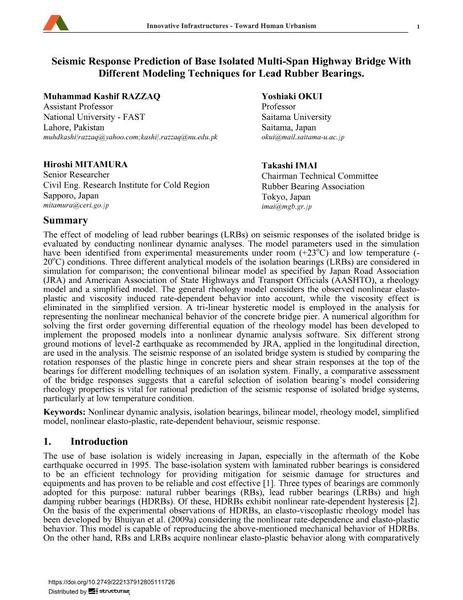Seismic Response Prediction of Base Isolated Multi-Span Highway Bridge With Different Modeling Techniques for Lead Rubber Bearings.

|
|
|||||||||||
Détails bibliographiques
| Auteur(s): |
Muhammad Kashif Razzaq
Yoshiaki Okui Hiroshi Mitamura Takashi Imai |
||||
|---|---|---|---|---|---|
| Médium: | papier de conférence | ||||
| Langue(s): | anglais | ||||
| Conférence: | 18th IABSE Congress: Innovative Infrastructures – Towards Human Urbanism, Seoul, Korea, 19-21 September 2012 | ||||
| Publié dans: | IABSE Congress Seoul 2012 | ||||
|
|||||
| Page(s): | 1227-1234 | ||||
| Nombre total de pages (du PDF): | 8 | ||||
| DOI: | 10.2749/222137912805111726 | ||||
| Abstrait: |
The effect of modeling of lead rubber bearings (LRBs) on seismic responses of the isolated bridge is evaluated by conducting nonlinear dynamic analyses. The model parameters used in the simulation have been identified from experimental measurements under room (+23oC) and low temperature (- 20oC) conditions. Three different analytical models of the isolation bearings (LRBs) are considered in simulation for comparison; the conventional bilinear model as specified by Japan Road Association (JRA) and American Association of State Highways and Transport Officials (AASHTO), a rheology model and a simplified model. The general rheology model considers the observed nonlinear elasto- plastic and viscosity induced rate-dependent behavior into account, while the viscosity effect is eliminated in the simplified version. A tri-linear hysteretic model is employed in the analysis for representing the nonlinear mechanical behavior of the concrete bridge pier. A numerical algorithm for solving the first order governing differential equation of the rheology model has been developed to implement the proposed models into a nonlinear dynamic analysis software. Six different strong ground motions of level-2 earthquake as recommended by JRA, applied in the longitudinal direction, are used in the analysis. The seismic response of an isolated bridge system is studied by comparing the rotation responses of the plastic hinge in concrete piers and shear strain responses at the top of the bearings for different modelling techniques of an isolation system. Finally, a comparative assessment of the bridge responses suggests that a careful selection of isolation bearing’s model considering rheology properties is vital for rational prediction of the seismic response of isolated bridge systems, particularly at low temperature condition. |
||||
